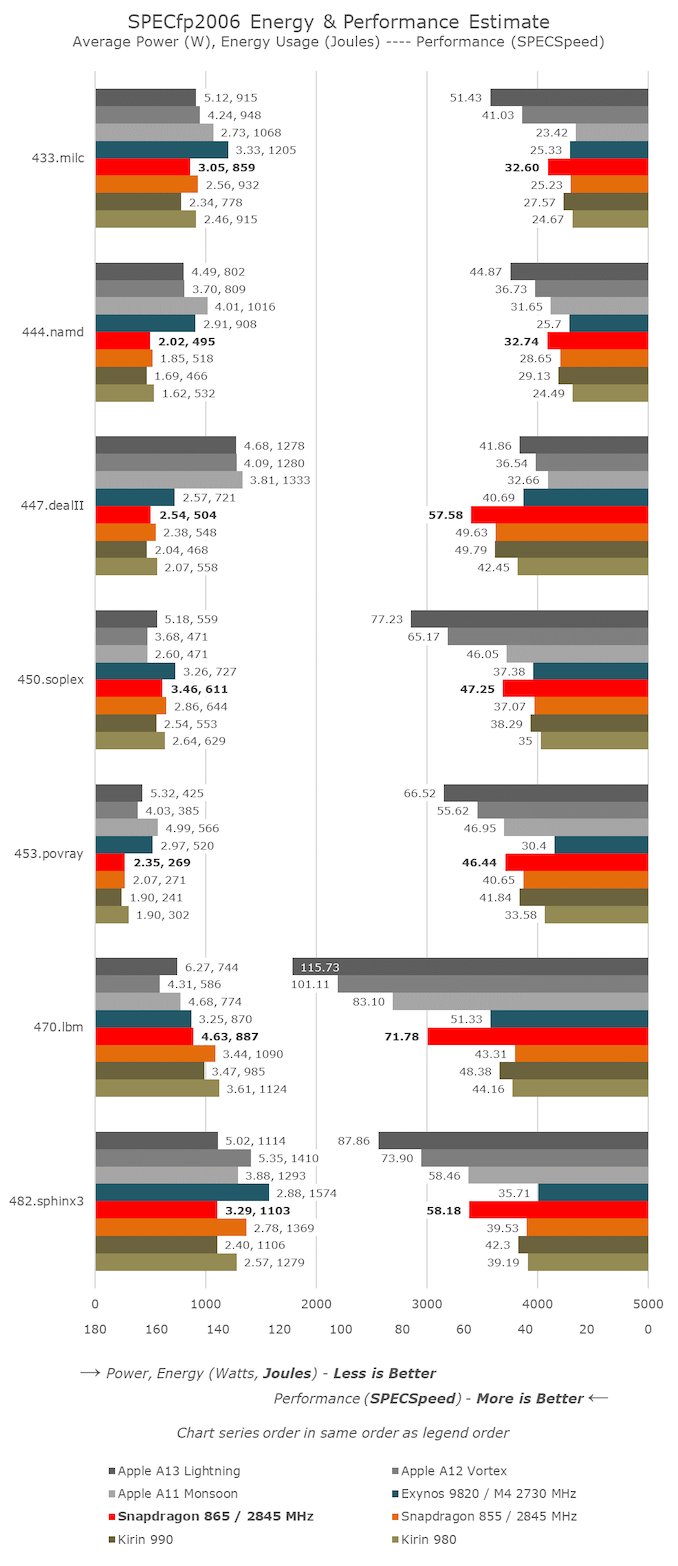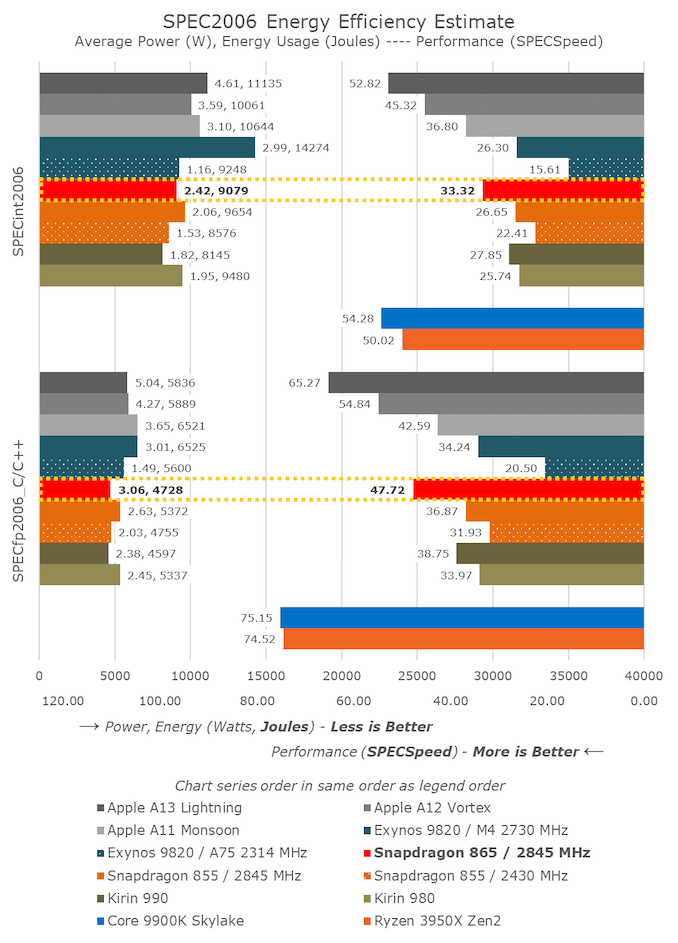The Snapdragon 865 Performance Preview: Setting the Stage for Flagship Android 2020
by Andrei Frumusanu on December 16, 2019 7:30 AM EST- Posted in
- Mobile
- Qualcomm
- Smartphones
- 5G
- Cortex A77
- Snapdragon 865
CPU Performance & Efficiency: SPEC2006
We’re moving on to SPEC2006, analysing the new single-threaded performance of the new Cortex-A77 cores. As the new CPU is running at the same clock as the A76-derived design of the Snapdragon 855, any improvements we’ll be seeing today are likely due to the IPC improvements of the core, the doubled L3 cache, as well as the enhancements to the memory controllers and memory subsystem of the chip.
Disclaimer About Power Figures Today:
The power figures presented today were captured using the same methodology we generally use on commercial devices, however this year we’ve noted a large discrepancy between figures reported by the QRD865’s fuel-gauge and the actual power consumption of the device. Generally, we’ve noted that there’s a discrepancy factor of roughly 3x. We’ve reached out to Qualcomm and they confirmed in a very quick testing that there’s a discrepancy of >2.5x. Furthermore, the QRD865 phones this year again suffered from excessive idle power figures of >1.3W.
I’ve attempted to compensate the data as best I could, however the figures published today are merely preliminary and of lower confidence than usual. For what it’s worth, last year, the QRD855 data was within 5% of the commercial phones’ measurements. We’ll be naturally re-testing everything once we get our hands on final commercial devices.
In the SPECint2006 suite, we’re seeing some noticeable performance improvements across the board, with some benchmarks posting some larger than expected increases. The biggest improvements are seen in the memory intensive workloads. 429.mcf is DRAM latency bound and sees a massive improvement of up to 46% compared to the Snapdragon 855.
What’s interesting to see is that some execution bound benchmarks such as 456.hmmer seeing a 28% upgrade. The A77 has an added 4th ALU which represents a 33% throughput increase in simple integer operations, which I don’t doubt is a major reason for the improvements seen here.
The improvements aren’t across the board, with 400.perlbench in particular seeing even a slight degradation for some reason. 403.gcc also saw a smaller 12% increase – it’s likely these benchmarks are bound by other aspects of the microarchitecture.
The power consumption and energy efficiency, if the numbers are correct, roughly match our expectations of the microarchitecture. Power has gone up with performance, but because of the higher performance and smaller runtime of the workloads, energy usage has remained roughly flat. Actually in several tests it’s actually improved in terms of efficiency when compared to the Snapdragon 855, but we’ll have to wait on commercial devices in order to make some definitive conclusions here.
In the SPECfp2006 suite, we’re seeing also seeing some very varied improvements. The biggest change happened to 470.lbm which has a very big hot loop and is memory bandwidth hungry. I think the A77’s new MOP-cache here would help a lot in regards to the instruction throughput, and the improved memory subsystem makes the massive 65% performance jump possible.
Arm actually had advertised IPC improvements of ~25% and ~35% for the int and FP suite of SPEC2006. On the int side, we’re indeed hitting 25% on the Snapdragon 865, compared to the S855, however on the FP side we’re a bit short as the increase falls in at around 29%. The performance increases here strongly depend on the SoC and particular on the memory subsystem, compared to the Kirin 990’s A76 implementation the increases here are only 20% and 24%, but HiSilicon’s chip also has a stronger memory subsystem which allows it to gain quite more performance over the A76’s in the S855.
The overall results for SPEC2006 are very good for the Snapdragon 865. Performance is exactly where Qualcomm advertised it would land at, and we’re seeing a 25% increase in SPECint2006 and a 29% in SPECfp2006. On the integer side, the A77 still trails Apple’s Monsoon cores in the A11, but the new Arm design now has been able to trounce it in the FP suite. We’re still a bit far away from the microarchitectures catching up to Apple’s latest designs, but if Arm keeps up this 25-30% yearly improvement rate, we should be getting there in a few more iterations.
The power and energy efficiency figures, again, taken with a grain of salt, are also very much in line with expectations. Power has slightly increased with performance this generation, however due to the performance increase, energy efficiency has remained relatively flat, or has even seen a slight improvement.














178 Comments
View All Comments
Bulat Ziganshin - Monday, December 16, 2019 - link
Unfortunately the first page lack latency picture for Core i9Ryan Smith - Monday, December 16, 2019 - link
Whoops! Reload and try it now.shabby - Monday, December 16, 2019 - link
Performance looks good but I'm really wary of the external 4g/5g chip and its additional antennas and how they'll affect battery life. Not going to buy any new sd865 phone until reviews pop up.eastcoast_pete - Monday, December 16, 2019 - link
That's the elephant in the room! Haven't seen any good real-world data on just how much power 5G use will actually add. Faster data are nice (in principle), but if 5G cuts battery life by 30-40% vs. current 4G LTE , pretty much useless. If anyone here has any links to such tests, please post - Thanks!Kangal - Friday, December 20, 2019 - link
Well, I think generally they're going to stick the 5G SoC next to the QSD 865 SoC.That means heat from one will affect the other, and so OEMs will potentially require a larger phone (and larger screen = more drain), but with a smaller area for the battery.
Not to mention, there is going to be significant battery life hit when using an external radio chipset instead of an integrated one. Remember the huge power savings we saw going from the QSD 600 to the QSD 800 back in 2013. So it will be kind of reversed.
I think overall, what will happen is that all the improvements in the battery technology and the Cortex A77 are going to be nullified. So phones from 2019 which had the best battery life and performance, are going to see a "side-grade" compared to 2020 flagships. So I believe in essence, the QSD 865 will be much less competitive against the Apple A13 and Exynos 990... compared to the QSD 855 against the Apple A12 and Kirin 980.
...I do believe more in-depth benchmarks and reviews will come within 3 months (and validate my hypothesis).
MrCommunistGen - Monday, December 16, 2019 - link
Based on the initial performance estimates from the Cortex A77 announcement article Andrei published back in May, I was actually really excited to see the next generation Snapdragon 865. The lack of performance uplift in the real-world web metrics with the QRD865 is a bit underwhelming, but my main concern is the requirement of an external modem.I don't have any experience with the current crop of 5G external-modem devices, but back in the day I used several Qualcomm APQ external-modem devices. Back then battery life being terrible was basically a given since batteries were small and Android was pretty bad at power management, but in hindsight I'm sure at least some of it was due to the external modems...
tuxRoller - Wednesday, December 18, 2019 - link
The disappointing web improvements were also seen last year (https://www.anandtech.com/show/13786/snapdragon-85..."The web-based benchmarks such as Speedometer 2.0 and WebXPRT 3 showcase similar relatively muted results. Here I had expected Qualcomm to perform really well given the scheduler performance showcase of the Snapdragon 845. The results of the Snapdragon 855 are quite meagre, especially in a steady-state throughput workload such as Speedometer 2.0. Here the Snapdragon 855 only manages to showcase a ~17% improvement over the last generation, and also lags behind the Kirin 980 by some notable amount."
However, compare those 855qrd to the numbers seen in this article with actual shipping devices. Pretty big difference.
generalako - Monday, December 16, 2019 - link
>Not going to buy any new sd865 phone until reviews pop up.Shouldn't really ever do that anyhow...
Kishoreshack - Monday, December 16, 2019 - link
Don't know why the Performance looks disappointing in web browsing testKishoreshack - Monday, December 16, 2019 - link
What is the reason is it performs worse than last years 855 chipare we gonna see same kind of implementation in real world devices?